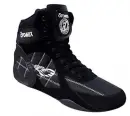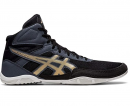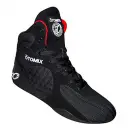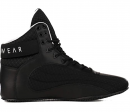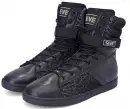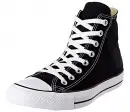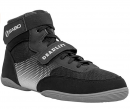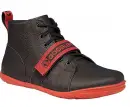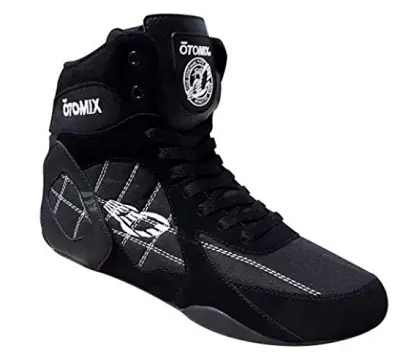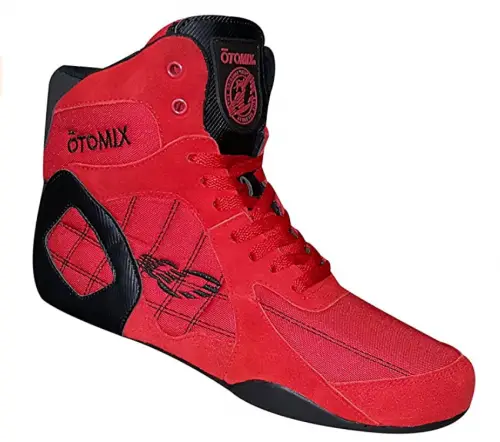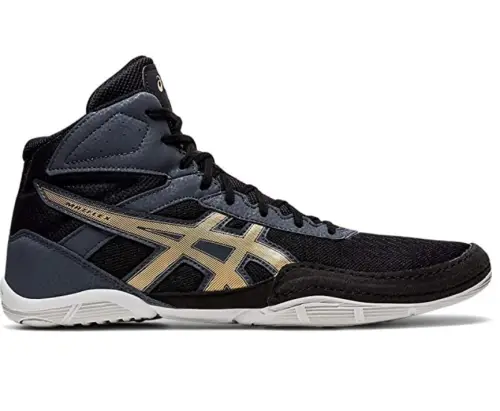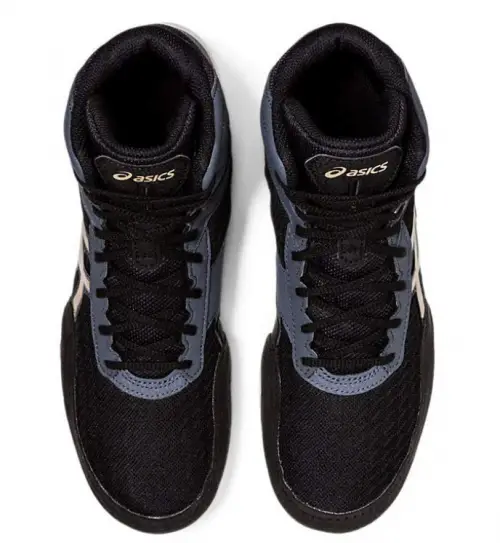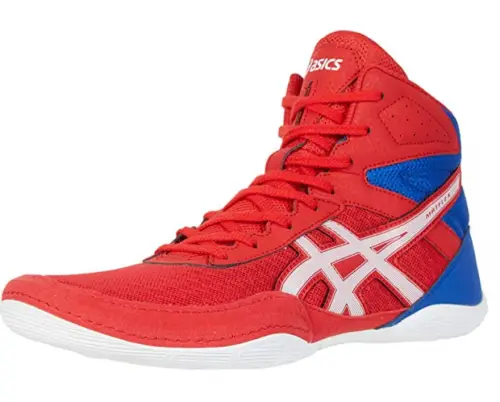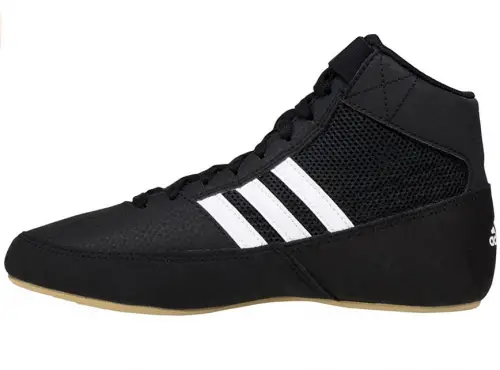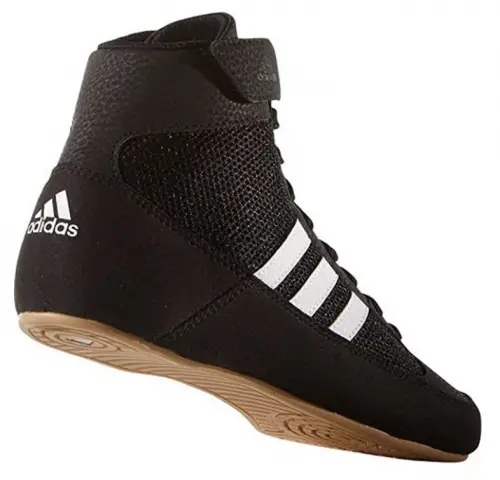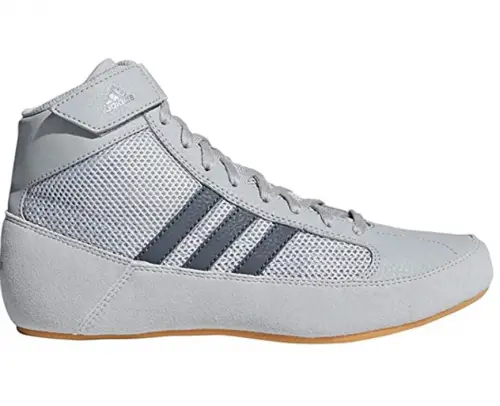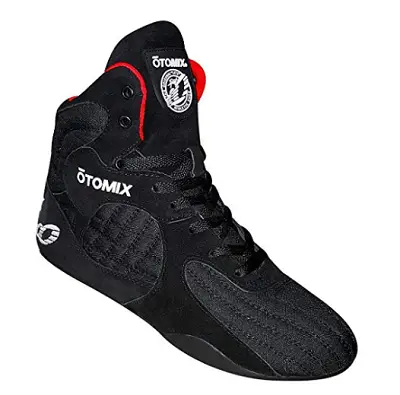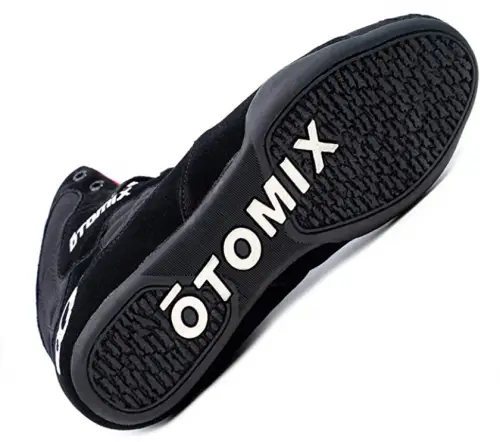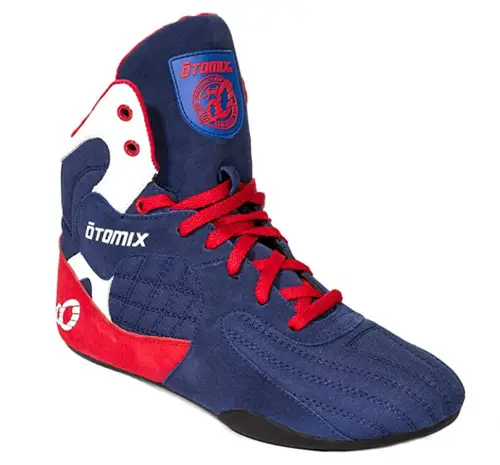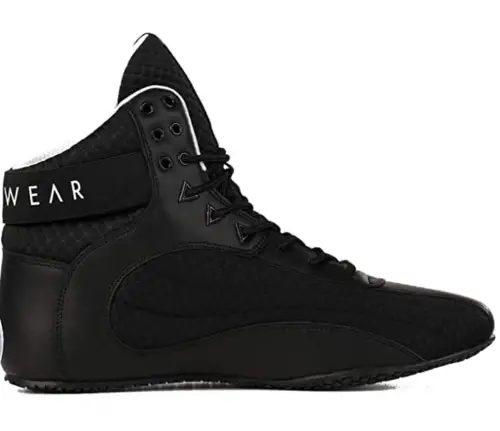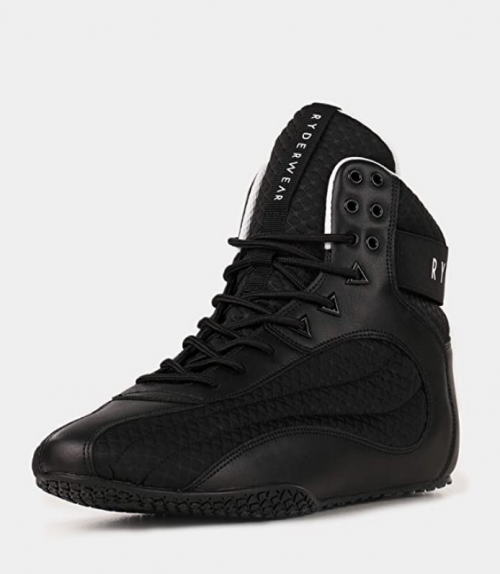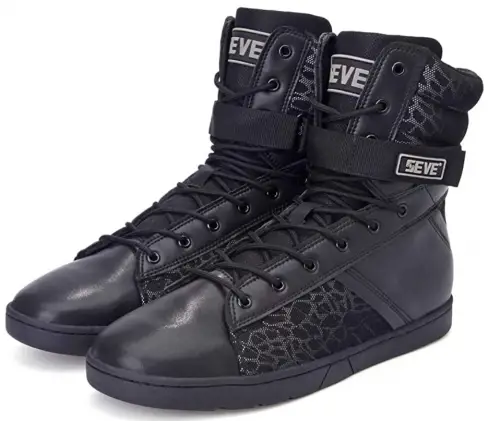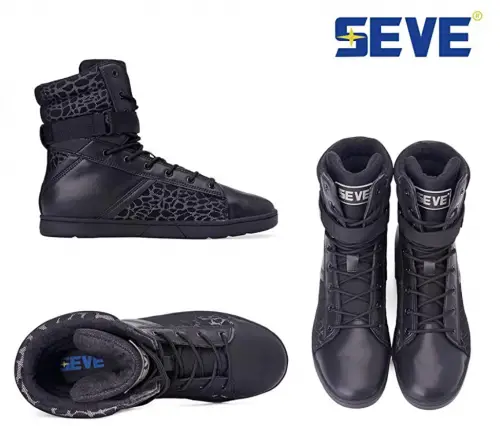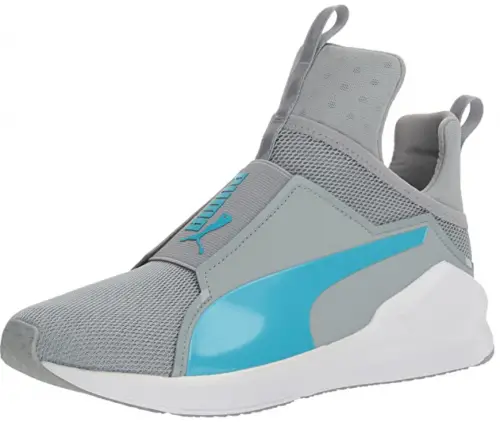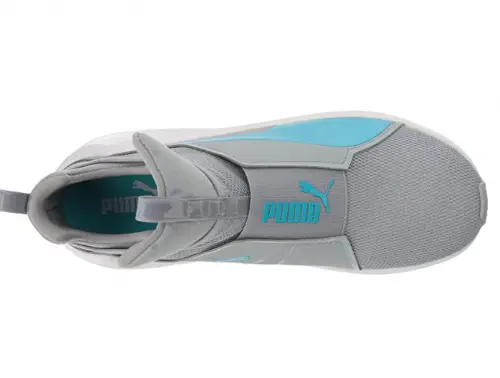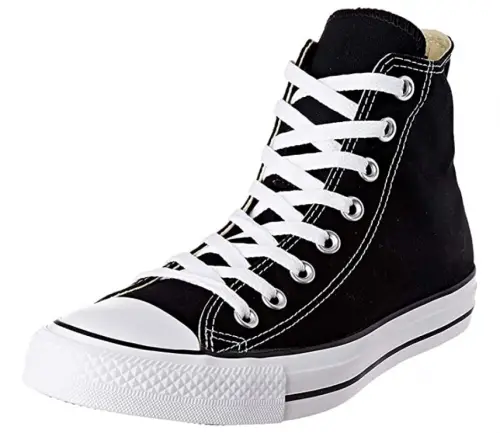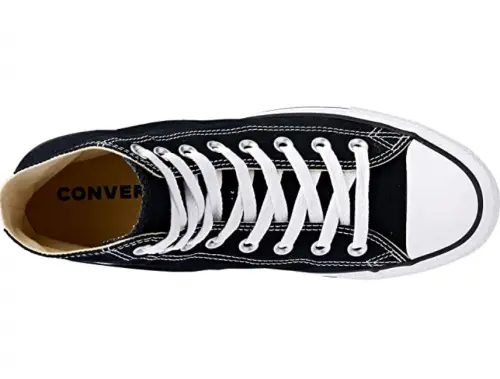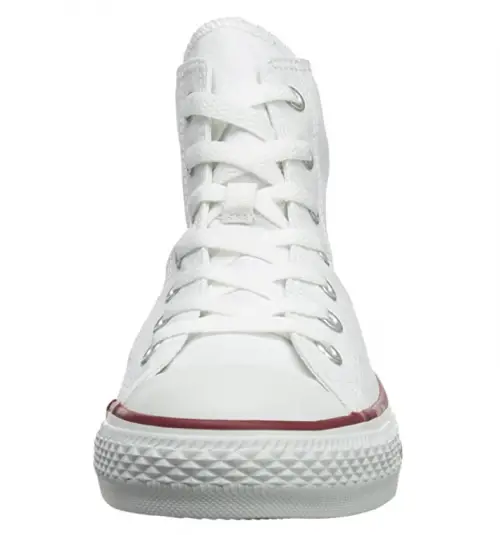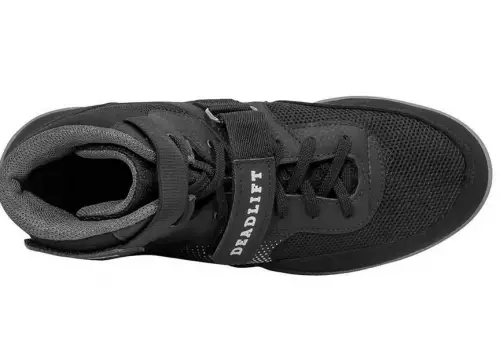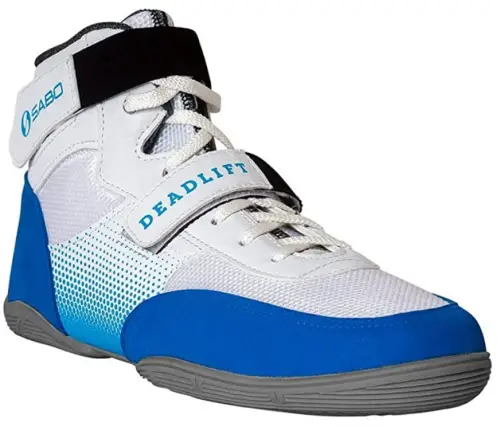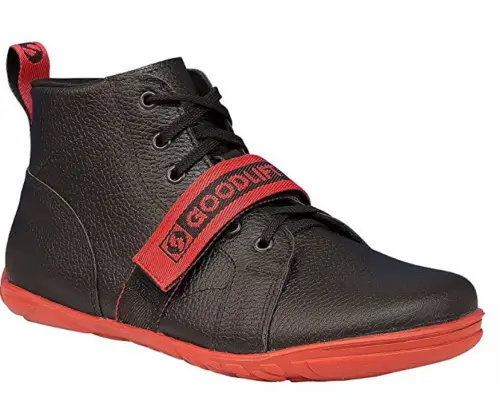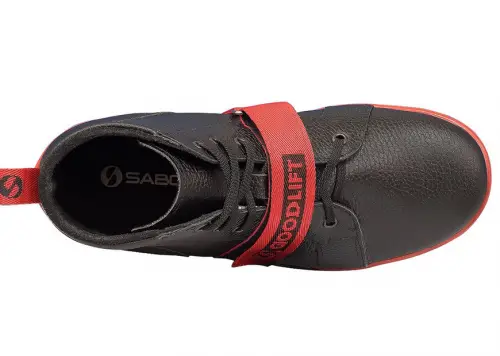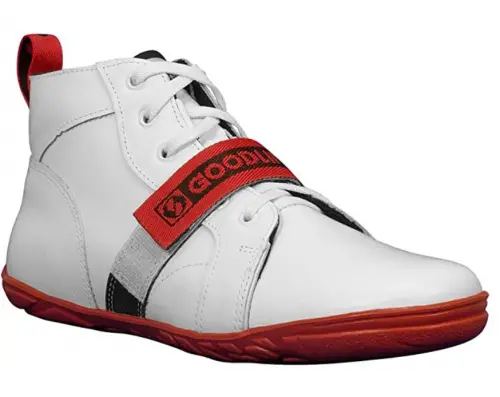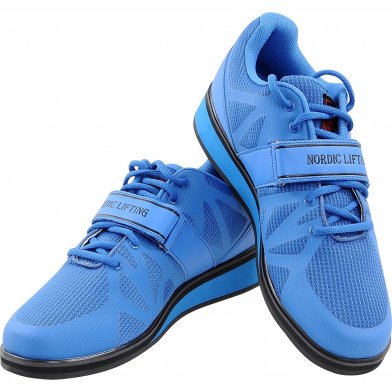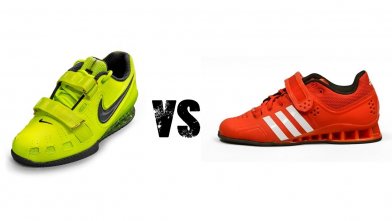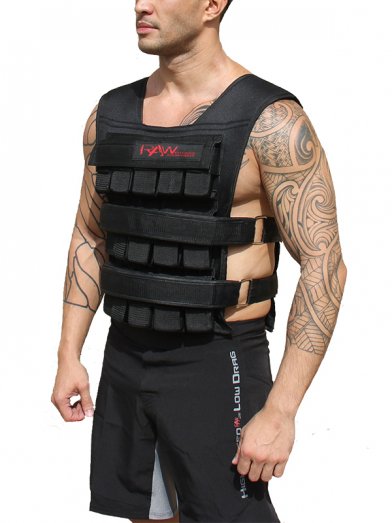Best High Top Shoes for Weightlifting
Proper footwear can be a real game-changer when bodybuilding or powerlifting. A good pair of high top weightlifting shoes are great because they provide a little extra lift and stability in the heel as well as heightened ankle support. If heavy squats are your favorite lift, high tops are a must. A higher frame provides extra stabilization to your ankles, which can help you engage in a more fluid range of motion that can actually cut down on injuries. We made sure to select designs that are lightweight and comfortable, as well as provide a little lift and extra support that come from tried and tested brands.
In this guide, we have selected some of the best high top weightlifting shoes to help you smash your next PR!
In a Hurry? The test winner after 20 hours of research
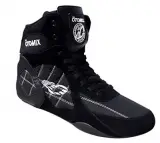
Wide roomy toebox
Grippy outsole
Thin sole, so your muscles do more lifting work
Breathable
Best High Top Weightlifting Shoes
1. Otomix Ninja Warrior
Wide roomy toebox
Grippy outsole
Thin sole, so your muscles do more lifting work
Breathable
Thin arch may be bad fit for some
These are versatile Otomix weightlifting shoes you can wear to lift weights or practice martial arts like boxing. The support provided by the ankle padding will keep you on your feet during either activity. The barely-there insole lets you drive your toes into the floor during squats, making sure you get the maximum benefits.
Read moreYou may want to purchase inserts if you have high arches, though. The rubber outsole gives you consistent traction and grip. You can move freely, being confident that you won't get injured as the shoes help immobilize your feet.
The Ninja Warriors are lightweight and won't cause you any ankle fatigue. This leads to longer workouts and better muscle gains over time. Synthetic leather and poly mesh make up the uppers. The materials make the shoe breathable and prevent your feet from sweating, cutting down on foul odors and bacteria growth.
The widened toe box adapts to wider feet and leaves you room to move your toes, using all of your foot for heavy lifts. The laces are designed to ensure a snug fit using Otomix's well known behind the tongue system. The laces will hold tight and will not get in your way during intense workouts.
2. ASICS Matflex 6
Affordable
Padded collar
Grippy outsole
Unique color options
Runs very small
Narrow fit
The Matflex 6 from ASICS is designed to be a minimalistic trainer that offers extra support where you need it most to really dig into those lifts. The high collar not only offers extra ankle support for squats but is also padded for extra comfort and protection. The best part about this minimalist design is that it clocks in at a super affordable price point.
Read moreOne of the very first things that we noticed about this design like in the high collar. While most lock your ankles in place with thin fabric, the Matflex 6 goes that extra mile for additional comfort and support. It boasts incredibly thick padding along the side of the ankle to lock them in place while providing an extra softness that is incredibly comfortable for those long training days.
We also noticed that the zero-drop outsole is packed with additional features as well to help you generate more power. What users really love about this design is that the outsole hosts innovative grooves along the base to keep you really planted and secure on the floor as you engage in your various lifts.
The best part about this supportive minimalistic design is that it clocks in at one of the most affordable price points out there on the market. Users love this design because it is lightweight, boasts comfortable padding along the collar, and a secure outsole that lets you really plant and generate a good deal of power.
3. Adidas HVC
Breathable upper
Locks ankles in place
Stylish design
Affordable
Runs very narrow
It’s hard not to fall in love with the initial design of this sleek shoe. This design from Adidas not only boasts a modern design, but it also hosts simple features that keep you in tune with the ground beneath your feet to generate power. It also boasts a snug upper that helps support your ankles as well. Plus, it comes in at a price point that won’t break the bank.
Read moreWe were initially drawn to the style as well as the function of the upper of this design. If you need something that really locks your ankles in place for extreme compound lifts such as squats or deadlifts, this is a great option. It boasts a padded collar for added support and flatlock laces that really anchor them to your feet.
It also hosts a wider footbed that allows your toes to splay inside of the shoe for added stability and support. The outsole of this design is thin and minimalistic and feels like you are wearing nothing at all. If you need something that feels like you aren’t wearing anything at all, this is a great option.
While we love the style of this trainer, it is also packed with supportive features that will help you generate a lot of power and keep your feet and ankles protected. Users love the added protection in the ankles and the overall fit and breathability of this design. We also love that it comes in at a super affordable price point that makes it worth checking out.
4. Otomix Stingray
Ideal for deadlifting
Breathable material
Tight lacing closure
Thin rubber sole for traction
No elevated heel for squats
This is a lightweight, boot-like lifting shoe that is flexible and lets you move around in safety while keeping your foot still enough to avoid injury. The sole has exceptional traction. Padding in the ankle helps support you and keep you stable.
Read moreThe structure of the shoe, including the minimal padding, makes it a good choice for deadlifts. There is no wedged heel though, so it will be harder to get a full range of motion when you squat. You can purchase heel lift inserts from many online retailers.
Traction is provided by a thin, flat, rubber sole. The outsoles grab hold of and rest on the ground until you are ready to move to another weight station. Since the laces start higher on the lower part of the shoe than ordinary sneakers, you get a tighter lacing job for a snug fit.
This shoe does not have a strap, which is typical for Otomix. The throwback style shoe comes in several primary colors, and in camo. Reviewers recommended ordering half a size bigger than your regular shoe size.
5. Ryderwear Raptors
Lightweight
Comfortable padded upper
Grippy outsole
Expensive
This design from Ryderwear boasts a fairly minimalist design, but it really shines in the construction of the upper. This option provides users with the ultimate protection for the ankles, and users find that it is super lightweight and comfortable enough to wear all day long. It’s one of our more expensive choices on our list, but the quality of construction makes it worth every penny!
Read moreWe were initially drawn to the construction of the upper of this design. It is composed of a velour style material with strong stitching that allows your foot to really flex inside of the shoe. It has strong padding on the ankles to lock them in place to prevent rolling, and the style of padding that contours to the shape of your foot to a great overall fit.
We also love that this design boasts a thin outsole that makes it the perfect shoe for deadlifting. It allows you to easily ground yourself to easily transfer energy to the ground when engaging in heavy compound lifts. Plus, the outsole is super grippy to prevent slipping when lifting on a platform.
If you are willing to spend a little bit extra on a shoe that is made for those tough compound lifts that provide extra protection where you need it and really connects you with the ground without being too constrictive, this design from Ryderwear is well worth the extra cost.
6. SEVE
High collar
Removable velcro straps
Thick rubber platform
Slightly expensive
Not very breathable
If you want something that packs in all of the extra bells and whistles for ultimate support, this design from SEVE is worth checking out. This design boasts a slightly higher frame than some of the other high top weightlifting shoes that we have seen so far, and the higher profiles offer a good deal of extra support. It may cost a little bit more than most, but it is well worth the slightly higher price tag.
Read moreThe very first thing that we noticed about this design is that the collar is a few inches higher than your standard high top designs. The laces span from the top of the toes to well over the ankles. And it also includes a set of removable velcro straps for extra support when you need it most.
The outsole of this design is similar to the Converse All-Stars. It boasts a thick rubber platform with zero-drop that allows you to generate a lot of power when engaging in compound lifts. Users love that the design of this outsole is incredibly supportive, but offer a good deal of flexibility as well.
If you are in the market for a sleek design that boasts a high profile and a good deal of added protection to your ankles when engaging in squats or deadlifts, this design from SEVE is a great choice. It cost just a little bit more than some of the other designs that we have seen, but the extra features make it an excellent value.
7. Puma Fierce Core
Easy to get on and off
Good as cross trainers
Arieprene is exceptionally comfortable
Extra heel support
No heel wedge for squats
This stylish trainer is made completely from synthetic Ariaprene, a fabric that offers exceptional durability, stain resistance, and natural ventilation for your feet. A rubber sole, not quite as thin as you'd see on straight weightlifting shoes, still provides stability and helps you plant your feet for Olympic style lifting.
Read moreMesh pieces in the upper and lower aid with heat dispersal. There are no laces, an unusual choice for a lifting shoe, but the Ariaprene keeps everything snug and in place.
A pull tab helps with getting the shoe on and off. Tongue and ankle collar feature padding. Puma built pivot points on the toe, heel, and outsole to facilitate a complete range of movement. Extra thick heels aid in squats and also keep you comfortable during wear.
The shoes are cute and comfy enough to wear away from the gym. The Ariaprene will keep them from getting dirty in the street. The shoes are even water-resistant in case you have to walk in the rain.
8. Converse All Star
Thick rubber outsole
Zero drop
1-inch rubber platform
Affordable
Stylish
Unreliable sizing
Who doesn’t love a good pair of Chucks? While you are on the hunt for the perfect pair of trainers for your powerlifting routine, they may already exist in your closet! What makes this simple and timeless shoe perfect for powerlifting is that it boasts excellent ankle support with simple fabric, and a flat rubber heel allows you to really dig into your lifts.
Read moreWhat we love most about wearing a good old-fashion pair of Chucks is that they are simple and lightweight. It boasts a classic canvas upper that contours to the shape of your foot, and the high lacing system allows you to tie them tightly for excellent ankle support (which is a must for squats!). The only downside to chucks is that the minimal arch support makes them great for weightlifting, and nothing else (we don’t recommend running in these shoes!).
All designs of Converse All-Stars provide wearers with zero drop, which feels like you aren’t wearing anything at all. This design makes it an ideal option for those that like to train barefoot. Where this design really shines is in the construction of the outsole. It is composed of a thick layer of responsive rubber, that provides a super stable foundation that allows you to generate more power.
The simple materials and timeless design make this design perfect for powerlifting. The thick rubber outsole not only provides additional support to keep you protected, but the high-top lace design helps to keep your ankles locked in place to prevent injuries. The best part? They are super affordable and stylish enough to wear all day long!
9. Sabo
Extra deadlift support
Durable construction
Thin rubber sole
Extra strap on the ankle collar
No squat assist
This sturdy shoe was made for doing deadlifts and will help you maximize your muscle use for substantial gains. The shoe is suitable for conventional deadlifts but has something special to offer the sumo deadlifting enthusiast.
Read moreSumo deadlifts use a much wider foot stance, with the feet angled outward to make things easier on the spine. The Sabo features thinner than average soles, good arch support, and the metatarsal strap, all to facilitate doing sumo deadlifts.
Although it's a sumo squatting dream, the Sabo is good for all of your standing or Olympic style lifts. There isn't a raised or wedge-shaped heel, for squatting, but a good pair of inserts can take care of that if you want the extra range of motion and downward pushing power.
Durable construction includes side support for protection from rolling your ankles. The outsole has a grippy bottom for stability. You get a full range of movement in these tough, lightweight lifters. There is an extra strap, across the ankle collar, for even more balance during deadlifts.
10. Sabo Goodlift
Nonmarking thin sole
Strong leather construction
Metatarsal strap
Grippy soles
Sole not perfectly flat
This option from Sabo has a lower ankle than its deadlifting counterpart and returns to the classic design of a single metatarsal strap. The upper and lower are solid leather, which promotes freedom of movement but may cause sweaty feet and odor if you do not clean the shoes regularly.
Read moreThe outsole is thin, but not perfectly flat like many lifters want to see on their shoes. The ankle is supportive but without excess padding or extra height.
There is no heel on the Goodlift. If heavy squats are a focus, you will need to get a pair of inserts. The outsole provides plenty of traction and grip. The strap keeps the shoe tight on your feet, keeping the feet still on the inside while still letting you move your toes. The leather is durable and will hold up for a long time under normal use.
You can get them up to size 13 men's/15 women's. Just make sure you use the sizing chart on the website, and you will be fine.
Criteria Used for Evaluation

Durability
Weightlifting shoes don't need to be weatherproof, but they do need to be gym proof.
By "gym proof," we mean that the shoes should be able to withstand hard floors, continue to provide shock absorption over time, not cause excessive foot sweat, and not stain easily or allow bacteria to flourish. Gym staff works hard to keep the gym clean, and most gym users are good enough to wipe down equipment, but any public place where sweat flows freely is susceptible to germs. This is why many shoes have antibacterial liners, either as standard equipment or as user-installed options.
Cheaper, poorly made shoes will cause you to sweat more and will absorb the sweat. They may also develop tears or splits, often after a short time of use. We want you looking and feeling your best. You should be able to meet your goals and focus on pushing weight, not constantly cleaning your shoes or having to replace them early. For this reason, we put a high priority on the durability factor. If you use them as directed, the shoes on our list will all perform well and stay strong for you throughout their life cycle.

Fit
The shoe's ability to snug your feet is at least as important as durability.
Many of the best weightlifting shoes are made outside of America, by international companies. There's nothing wrong with this, except that our American readers will need to consult the sizing charts. If you aren't familiar with European sizing, you could end up with pinched feet or blisters. Getting the right fit in the first place is always easier than having to do a return.
Also, many shoes do not run true to size, meaning that, if you normally wear a size 10, you may need a ten and a half, nine and a half, eleven, etc. We have talked about Converse Chuck Taylors as lifting shoes before, and Chucks are famous for this. If you typically wear an 11, for example, you may be more comfortable in size 10 Converses.
Aside from the actual numbers, the fit of a shoe comes down to its construction and inner material. Part of fit is subjective, too. You may need something with a wider toe box, or you may prefer shoes that fit like a second skin. It pays to learn about materials, design, and manufacturing processes as you narrow down which lifting shoe is perfect for you and your feet.

Flexibility
A lifting shoe has to be flexible for freedom of movement, while also having no give so that you and your muscles are doing the work.
Some materials are more flexible than others, and some shoes are more flexible than others. You'd never dream of wearing wingtips to go for a run, for example. But wingtips are perfect for formal occasions while being little suited to everyday life.
So it is with lifting shoes. They can't and shouldn't be as flexible as running shoes, because they don't have to absorb the repeated shock of your foot contacting pavement again and again. But if they are too rigid, you will not feel you can move around in them.
And unlike any running shoe, weightlifting outsoles have close to zero give. They are as thin as the soles you'd find on a pair of bowling shoes. This is so you can push your toe and heel down into the ground to get the weights up in the air. So the best lifting shoes walk a fine line between flexibility and firmness.

Outsole
The outsole is not the only thing that sets lifting shoes apart from ordinary gym shoes, but it's of crucial importance.
This is because the sole has to both absorb part of the impact, so your bones and joints don't bear the brunt, while also keeping you planted on the ground and providing traction. You could, conceivably, lift in bowling shoes, which we mentioned earlier. The soles are thin and have some give even though they are not rubber. But the bowling shoes have nowhere near the traction you need; bowling shoe outsoles are often smooth. You could lose your footing, which is not worth the risk.
Our point is that, if you are serious about lifting, you cannot compromise on the outsole. Your safety depends on it. So we carefully examined ratings, materials, thicknesses, customer reviews, and other specs. Our goal is to keep you moving and put you in the best position for achieving your fitness goals. Often, this starts with the outsole.

Stability
You need a stable platform, so what goes into the shoe matters.
Weightlifting shoes are not stability shoes. Those are for runners. If you go to a high end running shoe store, the staff members can put you on a treadmill right there on the sales floor. They will analyze your gait, taking your height, weight, and body frame into account. The instruments can tell if you are an overpronator (foot rolls towards arch) or underpronator (your foot makes too little contact with the ground). Either condition can cause injury. So, after the treadmill test, the staff will help you pick out a shoe with more or less padding, as needed.
What does this have to do with lifting shoes? Well, it is almost impossible not to overpronate when you do heavy squats. So lifted heels are important. Wedge-shaped inserts, too, can keep your arches high and make sure you drive your feet down towards the floor. Every modification or concession to human anatomy will affect how stable and balanced you are when you lift. So we have included shoes with little padding, abundant padding, and extra ankle support. This is all to help you reach that end goal of safe, productive, pain-free lifting.
Expert Interviews & Opinions
We have spent a lot of time talking about squats, including which shoes are and are not designed to optimize your range of movement during heavy squats.
But, as with any exercise, there is a right way to do squats along with many wrong ways that can lead to injury or impede progress. The best shoe in the world will not do much good if you don't have the basic squat motion down. Let's take a few minutes and do a quick recap of that motion.
Barbell squats should always begin with you facing the squat rack. Preload the barbell to your desired weight. The barbell should be at about shoulder height on the rack. Stand under the barbell and support it on your shoulders as you remove it from the rack.
Flex your hips to bend down, keeping the hips immobilized as much as possible. Your knees will push forward as you squat down, with your upper body as straight as possible. Make sure your knees align in the direction of your feet. If you are a beginner, practice this with an empty barbell first.
As soon as your upper legs make contact with your lower legs, stand back up, still keeping your upper body straight. At the top of the motion, either re-rack the barbell (for max heavy lifting) or check your alignment and squat down if you are doing multiple reps.
As you squat down, the weight should be centered on your heel as you drive into the floor.
There isn't anything wrong with low tops for weight training! The earliest lifting shoes were high tops, and they quickly became the standard. These were the early days of Otomix, the company that became iconic in the powerlifting community.
Low top lifting shoes will support your weight, help you grip the floor, and encourage you to use proper form. The high tops add extra ankle support, which is important if you are concerned about rolling your ankle. The support is augmented even more with ankle padding, which most of the shoes in this review feature.
Many lifters like low tops because they are easier to get on and off, or because they don't feel they need extra ankle support. Either way, the perfect weightlifting shoe is the one that meets your needs the best.
Other Factors to Consider

Breathability
A breathable shoe is one that provides a means for cooling air to flow around your feet and prevent overheating. Overheating can cause sweat, which in turn causes foul odors and bacteria that can cause athlete's foot and other conditions. For this reason, every weightlifting shoe has to have either porous material or ventilation holes (often both) in its design.
We are big fans of synthetic mesh because it is naturally porous, but leather can create a stronger feel and that might be important to you. In this case, the manufacturer will use lightweight leather, perhaps even synthetic, and will provide vent holes. Any shoe can be breathable, regardless of material, but it pays to look at what the manufacturer does specifically to keep you from having problems down the road.

Materials
The best high top weightlifting shoes are usually made of one or more common materials. The materials include genuine leather, synthetic leather, synthetic mesh, poly-fiber materials, canvas, and suede, though suede is rare. Poly fiber materials include Ariaprene, which Puma used for its Fierce Core slip-on high top lifter.
Each material has its own properties and its own requirements for cleaning. It is a good idea to look at these properties, to decide which shoe is right for you.
Leather is firm and secure, but not very porous, so breathability may be a problem. Often, leather lifters will have vent holes. Synthetic leather is lighter and more breathable than cow leather. Any leather shoe will keep your feet snug while allowing you to move freely.
Synthetic mesh and poly fibers are typically stained and water-resistant, lightweight, and extremely breathable. However, some lifters find the mesh too light, and prefer something with a bit more weight to it, like leather. Some lifters also have concerns about the environmental impact of the poly manufacturing process.
Canvas is tough and durable, though not as strong as leather. It is lighter and breathes better than leather does. However, canvas stains easily. There are consumer products you can buy to protect your canvas shoes.
Suede is not often used because it can stain so easily and is less durable than almost any other shoe material. Suede has a velvety texture, almost like fine fur. Suede also isn't very durable. When companies do use suede, it is usually for trim around the toe box area or the sides of the shoe. Suede looks great, and it is lightweight, so it isn't the worst material for lifting shoes.
Frequently Asked Questions
q: What is the purpose of weightlifting shoes?
When engaging in a compound lift, such as a squat, your ankles need to flex at an awkward angle to generate power. When you pop on a pair of lifting shoes with a supportive base and an angled heel or rubber platform, it cocks your ankle at a more natural angle. When your feet and ankles are properly supported, you prevent injuries, and they can even help you lift even heavier weight.
A supportive midsole and outsole will also help you get the most out of your lifts. Some designs boast a platform or a raised heel to lend extra stability and power, while others boast a more minimalistic approach to allow your feet to really dig into the ground beneath your feet. The style of the outsole generally boils down to a matter of personal preference.
q: Do weightlifting shoes make a difference?
Absolutely! While many lifters prefer to lift without shoes, there are some pretty killer benefits to donning a quality pair of high tops. Some of the designs selected for our list boast a slightly elevated heel that can make a big difference not only with your deadlifts and squats but also your bench press.
A slight heel or raised platform provides a more fluid range of motion and also allows you to really press into your heels to generate a lot of power for those really heavy lifts. They also help craft a more stable and steady base, and they can also work to even prevent injuries!
q: Should I buy weightlifting shoes as soon as I start weight training?
We suggest not doing so and holding off. This is because ordinary tennis shoes will meet the needs of neophyte lifters who are not ready to lift large amounts of weight. When you start, you should take some time to learn to build your own routines. Knowing which muscles each lift will target is a part of this. Go for the lifting shoes later, when it becomes clear that you need the mechanical advantage to maximize your squat weight.
Remember, too, that it's okay never to get into heavy lifting. Regular workouts with dumbbells, bench presses, and squat machines at a comfortable weight will make a big difference in your strength and overall well being.
q: What will lifting shoes do for me, when I am ready for a pair?
They will help you avoid injury, which we always stress is the most important consideration. You can't skimp on safety. However, in addition to the added stability and protection, the right pair of lifting shoes will actually help you lift more weight. This is because they are built specifically to give you a mechanical advantage and keep your form as close to perfect as it can be.
q: My friend lifts barefoot and swears by it, because she says she's doing all the work herself with no help from the shoes. Is that true?
Barefoot lifting can set you up for overuse injuries, and the bottoms of your feet will not give you the same traction as a good pair of minimally padded lifting shoes. These are reasons enough to think about getting shoes for weight training. But remember, lifting shoes are also designed to give you an advantage with their raised heel and extra thin sole.
If you are into functional fitness, too, it is unlikely you will need to lift over a hundred pounds, outside the gym, with no shoes on. So using the shoes is not weakening you any more than using power steering on your car is.
q: How exactly does a pair of these shoes improve my squat performance?
The shoes will help you keep your torso upright, letting you use your large muscle groups more efficiently and without pain.
q: Can I wear my lifting shoes as everyday shoes?
You are free to wear them whenever you wish! However, there are a few compelling reasons to reserve them for your lifts and nothing else. The first reason is a matter of wear and tear. These shoes can often come in at a pretty steep price point, which means you will want to limit the overall wear and tear on the soles.
The second reason is psychological. When we lace up our trainers, there is a shift that happens inside of our brains. Whether you are lacing up a pair of running shoes or powerlifting shoes, the simple act of popping on these shoes shifts your brain into workout mode. Once your shoes are laced up, there is no turning back!
Sources
- , Myths and Misconceptions –Lunges and Squats, Training Certification Website
- , The Effects of Weightlifting Shoes on Squat Kinematics, University Research Website
- , Do specialty shoes boost weightlifting performance?, Physical Therapy Trade Journal












